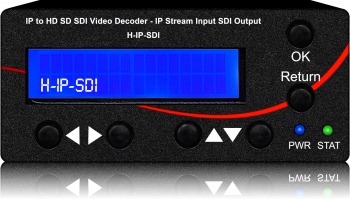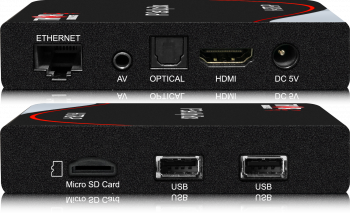Basic Features:
- ATSC3.0 / ATSC1.0 Tuner
- 4Kp60 AV1; 4Kp60 10-bit H.265; HDR, Dolby AC4
- System upgrading:Upgrade software via USB or network (OTA)
- Built in ATSC3.0 App [Over the AirTV]
- Built in Youtube, NETFLIX, etc
System
- SoC: Amlogic S905Y4-B
- CPU: ARM Quad 64-bit Cortex-A35
- GPU: ARM Mali-G31 MP2
- DRAM: LPDDR4 2GB
- Flash: eMMC 8GB Packaging list
- OS: Android™11
- DRM:Widevine, Playready
Video Decoder:
- AV1 MP-10 4K*2K@60fps
- H.265 HEVC [email protected] up to 4K*2K@60fps
- VP9 Profile-2 up to4K*2K @60fps
- AVS2-P2 up to 4K*2K@60fps
- H.264 AVC HP up to 4K*2K@30fps
- MPEG-4 ASP@L5 up to 1080P@60fps
- MPEG-2 MP/HL up to 1080P@60fps
- MPEG-1 MP/HL up to 1080P@60f,
- AVS+ JiZhun Profile up to 1080P@60fps
Video Format:
Audio Decoder:
- MPEG1/2
- MP3
- AAC/HE-AAC
- FLAC
- OGG
- DD
- DD+
- Dolby AC4/AC3
Audio Format:
Network:
- 2x2 MIMO Wi-Fi 2.4GHz/5 GHz 802.11 a/b/g/n/ac
Connectivity
- Video/Audio output:HDMI 2.0 support CEC
- USB input: USB2.0
- Power Interface:DC 5V 2A
Other
- Input voltage:DC input 5V 2A
- Power consumption:10W Max
- Operation temperature:0~40
- Material: Plastic & Aluminium
- Accessories: IR Remote, 5V 2A DC Adapter
Hardware Information Context:
The difference between the ATSC 1.0 and ATSC 3.0 modulation standards lies in their underlying technologies and capabilities. ATSC 1.0, also known as the ATSC A/53 standard, is the current digital television standard used in the United States. It primarily relies on 8VSB (8-level Vestigial Sideband) modulation for transmitting over-the-air television signals.
On the other hand, ATSC 3.0, also known as NextGen TV, represents a significant advancement over ATSC 1.0. It employs a more efficient and flexible modulation scheme called OFDM (Orthogonal Frequency-Division Multiplexing), which enables higher data throughput and better robustness against signal interference. OFDM divides the available spectrum into multiple narrowband orthogonal subcarriers, allowing for more efficient use of the frequency spectrum compared to the single carrier modulation used in ATSC 1.0.
In addition to OFDM, ATSC 3.0 incorporates other modern technologies such as HEVC (High-Efficiency Video Coding) for improved video compression. HEVC offers better compression efficiency than the MPEG-2 compression used in ATSC 1.0, allowing broadcasters to deliver higher resolution content like 4K Ultra HD or multiple HD channels within the same bandwidth.
The bandwidth efficiency of ATSC 3.0 is also enhanced through the use of advanced error correction coding and adaptive modulation techniques. These technologies help mitigate the effects of signal fading and interference, ensuring a more reliable reception even in challenging environments.
ATSC 3.0 also introduces support for hybrid broadcast and broadband delivery, enabling broadcasters to offer a wider range of services, including interactive content, targeted advertising, and emergency alerts delivered over both broadcast and internet protocols.
Currently, ATSC 3.0 deployment is underway in the United States, with several broadcasters already launching NextGen TV services in select markets. The transition from ATSC 1.0 to ATSC 3.0 involves a gradual rollout, with broadcasters upgrading their transmission infrastructure and viewers gradually adopting compatible receivers. During the transition process, broadcasters may utilize "lighthouse" broadcast stations to simulcast ATSC 1.0 and ATSC 3.0 signals in order to ensure a smooth transition for viewers.
The timeline for full implementation of ATSC 3.0 may vary depending on factors such as broadcaster readiness, consumer adoption of ATSC 3.0 receivers, and regulatory considerations. However, as more broadcasters transition to NextGen TV and ATSC 3.0-compatible devices become more widely available, the adoption of this new standard is expected to accelerate in the coming years.

 ES
ES












